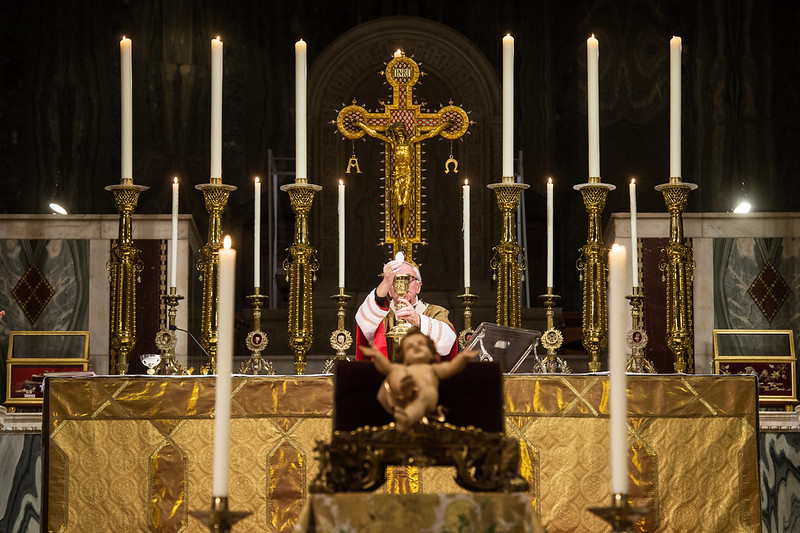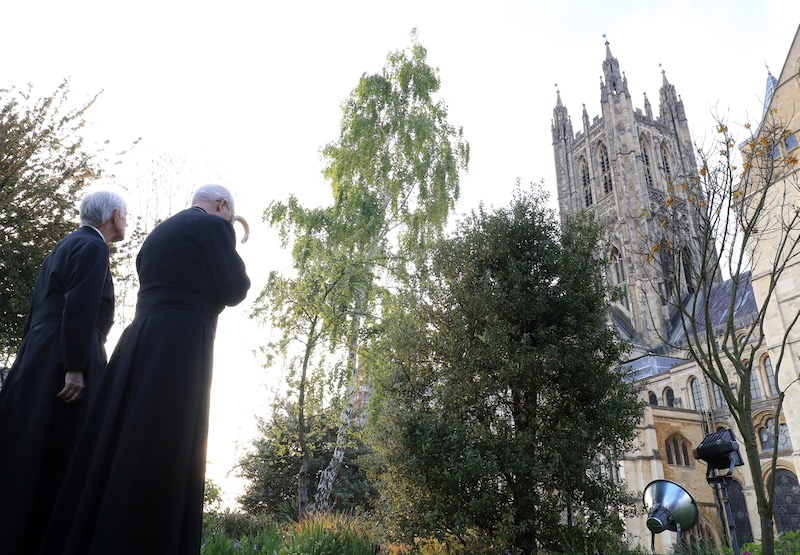St Thomas Becket has been one of the many victims of Covid-19. Today should’ve marked the culmination of a year of celebrations and events honouring the 850th anniversary of his bloody martyrdom at the hands of four knights in Canterbury Cathedral on the 29th December 1170. Alas, the annual service at Canterbury Cathedral held at the hour of Vespers, the very moment of the archbishop’s brutal death, has been moved online. The British Museum exhibition devoted to the saint has been postponed – vaccine rollout permitting – until early next year. It’s all so 2020 – muted, virtual, on hold and not at all what was originally envisaged.
It’s precisely because of this that I want to pen a column in honour of St Thomas Becket, or St Thomas of Canterbury as he was known in the Middle Ages, when he was among England’s most popular saints, pilgrims flocking to his relics at Canterbury Cathedral. Venerated as a holy martyr, Becket is also a case study of how the most unlikely and unlikable of individuals can achieve sanctity.
Indeed, despite the best efforts of medieval hagiographers, there’s scant evidence of principle, piety or holiness in Becket’s early life. Of Norman descent, Becket was born in London in 1118. His father was among the city’s mercantile elite and the young Thomas had the best education that his money could buy, first with the Augustinian canons at Merton Priory and then at Paris and its nascent university. The fact that the Sorbonne was a crucible of thought and intellectual discovery doesn’t seem to have made much of an impact on the teenage Thomas. Tiring of the study of Grammar, Rhetoric and Logic, the mainstays of the medieval undergraduate curriculum, he dropped out and returned to London.
Finding employment as a financial clerk, he set an example for generations of Cockney wide boys to come, showing that the lack of a university degree was no impediment to prospering in the real world. Set on a path to success, Becket’s talents soon secured a place in the household of Archbishop Theobald of Canterbury.
A career as an influential functionary in ecclesiastical administration beckoned. It might not sound exciting to us, but these often-anonymous cogs in the wheels of the day-to-day administration of the medieval Church enjoyed wealth, power and status and had sufficient ready cash to enjoy a sumptuous lifestyle. After legal studies in Europe, Becket was ordained deacon and elevated to the office of archdeacon of Canterbury in 1154.
It was in this role that he encountered the young King Henry II, who in 1155 appointed Becket as his Chancellor. It was a role for which he was eminently qualified. Thomas maintained a lavish lifestyle that befitted his high estate, and despite his plebian birth, formed a firm friendship with the king.
In 1162, Becket’s erstwhile patron Archbishop Theobald died. In an act of twelfth-century chumocracy, King Henry engineered Becket’s election to the vacant throne of the archbishop of Canterbury. The fact that Becket was not yet in priestly orders was soon remedied.
This appears to have been a moment of genuine religious conversion for the hitherto worldly Becket. Much as he delighted in being kitted out in full archiepiscopal splendour, contemporaneous biographies describe how Thomas also wore a monastic habit beneath his silken robes, while next to his skin was a hair shirt crawling with vermin – unmistakable acts of humility and penance.
Henry’s hopes that Becket’s appointment would ensure a cosy relationship between Church and State were rapidly thwarted. The king soon came to regard Becket as something of a God-botherer, the archbishop taking it upon himself to offer unsolicited, high-handed, patronising religious counsel to his king.
Worse was to follow, archbishop and monarch becoming embroiled in a bitter dispute about various ecclesiastical privileges, especially the issue of “criminous clerks” – the jurisdiction of the King’s courts over clerks or clerics (which could mean anyone in even the most minor of holy orders) accused of offences as heinous as rape and murder. Matters came to a head in 1164 when Henry issued a set of legal decrees known as the Constitutions of Clarendon. Becket’s refusal to put his name to the document led to him being summoned to attend the king at Northampton. A defiant and largely friendless Becket appealed to the Pope and fled to the Continent.
Six long years of exile followed until a peace of some sorts was cobbled together in 1170. But the fundamental problems remained unchanged, not least Becket’s cantankerous personality and intransigence. This is no better shown than his reaction to the coronation by the archbishop of York and the bishops of London and Salisbury of Prince Henry, the “young king”, as the co-monarch of Henry II. Believing that the coronation rights of the archbishop of Canterbury had been violated, Becket excommunicated the three officiating prelates, thereby undermining the legitimacy of the whole coronation procedure.
On hearing the news, an enraged Henry II is said to have declared: “What miserable drones and traitors have I nourished and brought up in my household, who let their lord be treated with such shameful contempt by a low-born cleric.” In the modern, popular imagination this has been bowdlerised as “who will rid me of this turbulent priest?”
Four knights took this to mean that Henry wanted Becket in chains (at the very least), and accordingly travelled to Canterbury where Becket, having returned to his diocese in triumph just four weeks earlier, was keeping Christmas.
The knights, having left their swords outside, attempted to arrest Becket in his hospitable hall. Thomas refused to come quietly and with their blood rising, the knights left to retrieve their weapons. Realising that violence was afoot, the archbishop’s retainer hurried him into the nearby cathedral, where the monks were gathering to sing the late afternoon service of Vespers. Becket forbade the terrified monks to bar the cathedral’s doors, ordering: “It is not right to make a fortress out of a house of prayer!”
Thomas bravely stood his ground as the knights approached, rejecting their charge of treason and declaring himself a “true servant of God”. A scene of horror then unfolded. Becket’s priestly tonsure, the shaved crown of his head, was severed from his skull, the point of a sword used to scatter the archbishop’s brains on the cathedral’s pavement. Medieval knights really were sadistic thugs.
This act of appalling sacrilege made a martyr of Becket and miracles were soon attributed to his intercession and blood-soiled relics. Thomas was canonised by the Pope in 1173, his shrine at Canterbury Cathedral among the “A” league pilgrim destinations of medieval Europe.
The pilgrimage continued until St Thomas of Canterbury, the defiant opponent of royal authority and champion of the privileges of the Church and papal jurisdiction, fell victim to Henry VIII’s Reformation. The saint’s name was struck from service books, his relics deliberately annihilated, their surrounding shrine, one of the wonders of medieval English art, plundered for its jewels and precious metal.
Today a solitary candle marks its site: its flickering light powerfully sustains the memory of St Thomas’s conscience, principles and bravery. At this dark time – in every sense – it also burns as a beacon to guide us to a brighter future.



 Loading ...
Loading ...
What do you think?
You can post as a subscriber user ...
User comments (0)